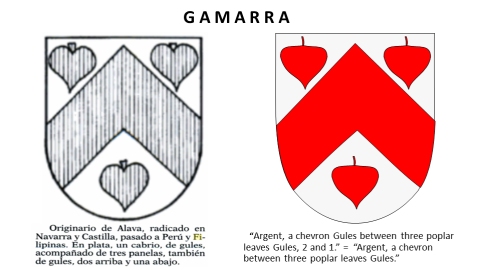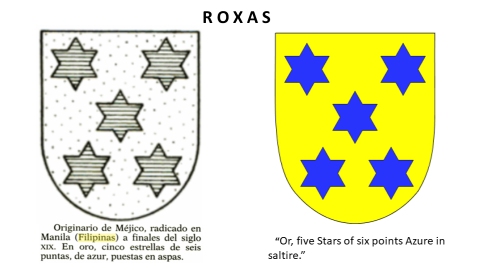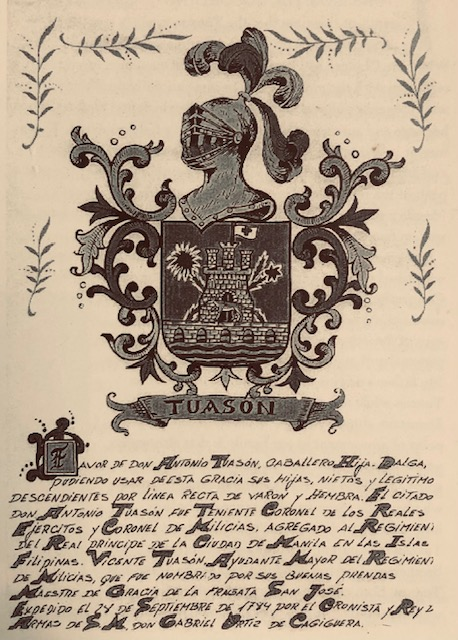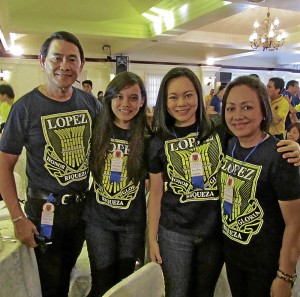Coat of arms of King Felipe II, the King of Spain during the Spanish conquest of the Philippines. Though there is no record of him actually coming to the Philippines, as reigning monarch his coat of arms would be the first personal coat of arms connected to the country. Image by Heralder from Wikimedia Commons.
Heraldry would have first came to the Philippines during the Spanish conquest of the 16th-century. In the Spanish tradition, hidalgos (“nobles”, a title generally earned through military service to the monarch of Spain) adopted coats of arms to identify themselves, their families and their property.
The historic Raymundo House in Malabon City was built for Dr Jose Raymundo in 1861. A coat of arms is engraved above the door, described as a Hapsburg eagle. Image by Judgefloro from Wikimedia Commons.
These coats of arms were regulated by a Spanish Cronista de Armas (“chronicler of arms”), and passed on to their children. As Spanish conquerors and colonists intermarried with Filipinos, those Spaniards with coats of arms would have been entitled to pass them on to their descendants in the Philippines.





Coat of arms of various Spanish settlers in the Philippines. Images from Heraldario español, europeo y americano by Vicente de Cadenas y Vicent, Cronista Rey de Armas via Sebastian Nelson at the International Heraldry Society Facebook group. Blazon translation by Antonio Salmeron Cabañas. Colored emblazonments by Rendell Salgado.
Similarly, some Filipinos were granted coats of arms directly from the Spanish crown for service to the colonial government. For example, Antonio Tuason, a Chinese mestizo, was made a noble by King Carlos III in 1783 and received a “colorful coat of arms“. In his will, he ordered his descendants “shall also display my coat of arms upon all his crests and buildings and he who shall fail to do any of these things, shall forfeit his right of succession.” Senior members of the clergy, such as Archbishops or Cardinals, would have also adopted shields as they rose through the Church hierarchy.

Arms of Antonio Tuason. Image from “A noble Filipino family”, Manila Bulletin, April 3, 2022.
Unfortunately, there is no central record of these coats of arms or who has inherited them in the Philippines. Although there are some Philippine engravings and prints from the Spanish era that are found in libraries from time to time, it is mostly up to families themselves to make sure that their shields and the history behind them are passed down from generation to generation.
The Villanuevas of Vigan can trace their heritage to a Spanish administrator from the Basque region who settled in the area. The family coat of arms features Spanish noble elements, including the robe behind the shield, and the helmet with golden bars. Image by Eileen Paat from GMA News.
During the American occupation, personal heraldry in the Philippines became unregulated: the United States had no laws that control how coats of arms are adopted or passed on. (Of course, even without official heraldic laws or a heraldic authority, America has well-developed traditions that shape Philippine heraldry. Learn more about them at the American Heraldry Society.)
A Philippine Heraldry Committee was created by President Quezon in 1940, but was responsible only for government heraldry. It did not concern itself with personal heraldry.
Even after Philippine independence, personal heraldry remains today entirely up to individuals and families. Although a Philippine Heraldry Committee was formed in 1940, succeeded today by the National Historical Commission of the Philippines, it deals only with government heraldry, like official seals and flags, and military symbols. (Learn more about government heraldry on the Interactive Registry of Government Seals and Symbols of the State.)
The 1993 Araneta family reunion in Iloilo printed a program that features a coat of arms. Image from the Araneta clan.
Today, Filipinos often use heraldry as a way to celebrate their family history. Coats of arms connect modern families with past generations and link with those to come. In fact, heraldry is often seen at family reunions: they remind relatives of the bonds that bring them together.

The Villanueva coat of arms is featured on a banner at their family reunion. Image from La Familia Villanueva de Ylocos.
Some families without existing shields even decide to create them at reunions, as a way to commemorate their ancestors and continue their ties to the future. For overseas Filipinos, coats of arms not only maintain a sense of belonging to family and homeland, but also capture our cultural heritage to share around the world.
The Lopez family printed a shield onto T-shirts for a reunion in Iloilo in 2013. The symbol appears to be a sheaf of sugar cane. Image from Inquirer.net.
As a sign of personal or family identity, heraldry is versatile and adaptable to all sorts of purposes. The coat of arms can be portrayed on the usual shield, or with accoutrements specific to one’s profession, like the stole and hat in some religious communities. Elements from the arms can be used as a badge, traditionally worn by those loyal to or in the service of the armiger. Flags and banners are also used, to mark homes and property, and can be a dynamic and vibrant way to display the arms outdoors.

The arms of Rendell Tamaca Salgado are depicted in various forms, illustrating the versatility of heraldry and the clarity of his personal symbols. Image from the Armiger.
Perhaps most importantly, heraldry captures the imagination of old and young alike, and ensures that family identity and history remain alive across generations.

The son of Rendell Tamaca Salgado proudly bears his father’s arms, ready to carry his family identity to be celebrated by future generations. Image from the Armiger.
Join the Filipino Heraldry Society, the Philippine Heraldry and Vexillology and the Heraldry Guild of the Philippines on Facebook to learn and share more about heraldry in the Philippines.






I would like to create my own coat of arms, just for personal use or representation. I really like this page. Very informative. I never knew that there are some existing coat of arms in the Philippines. I am planning to share my coat of arms to my siblings, and if they will pass it to their children, then I would be grateful. For me it is an artistic way to represent yourself or your family through symbols or charges. I just don’t know how to make it official though
LikeLike
Hello Sir Bong, thanks for the comment. In the Philippines you are free to create a coat of arms and use it as you wish, as long as it does not copy the design of someone else. To make it “official”, you simply need to create it and use it – just like most of the world, including the US, there is no official registration of personal coats of arms in the Philippines. Once you create your coat of arms, please share it with us – we will publish it here so that is is recorded for your family and the world to see. This will help make sure that your family and friends will know the meaning of your design, as well as establish that the design belongs to you and prevent others from copying it. Thank you again Sir Bong!
LikeLike
I have my family coat of arms. How to register it so that no other family can copy it? Is there an agency in the Philippines that would make my family arms officially used by me and my descendants alone?
LikeLike
Hello Sir Eric, thanks for the question. Currently there is no official government agency that can register your family arms or enforce your wish that your family and descendants alone may use it.
However, by submitting it to the Philippine Armorial, we will publish it here, along with any design rationale or history you wish to share. That way, there will be a publicly-available record online that establishes your claim to the arms, as well as a reference for your family and descendants. We do not charge any fee for this service.
You could also register your coat of arms as a trademark. However, you would need to establish that you are using the arms as part of a trade or service. In other countries, some people have registered arms as a trademark for “all trades” (for example, a Canadian registration at http://www.ic.gc.ca/app/opic-cipo/trdmrks/srch/viewTrademark?id=0916322&lang=eng&tab=reg). In the Philippines, it is unclear if you actually need to be engaged in a trade or service to register a trademark. If yes, then it is probably impractical to try as you would need to set up the necessary businesses to satisfy the requirements. If no, then this could be an option for you.
We suggest reviewing the info at https://ipophil.gov.ph/services/trademark/about-trademark and contacting a lawyer for more information. You might also be interested in the information at https://www.americanheraldry.org/education-resources/grants-and-registrations/heraldic-registration-in-the-united-states under “Why not trademark or copyright my arms?” – this is an American site but the situation is similar here.
Thank you again Sir Eric!
LikeLike
Thank you for your very informative reply Philippine Armorial. I wish I could share my COA on your website. Atleast by that way there would be an easy access for my children to claim their right of usage of our own family COA.
LikeLike
I really wanted to post my coat of arms and its full armorials on your site (philippinearmorial) but I fear somebody would in the future copy it and make it his own. Or one of its symbols be transported to another individuals’ or another families’. That I will never allow for all eternity. This is the only way I know how to preserve our ancient identity that was relayed to me by my great grandmother. It is 12 symbols unified in a single shield; TAMING in my own language (bisaya). As the current head of my clan, I modified it and codified it as it is to be the final COA of my bloodline.
I really hope that in the Philippines, there would be strong agency that will protect a family identity, just like the family COA/ armorials.
Thank you for your reply. Best regards!!!!
LikeLike
Good day philippinearmorial. Can you consider my coat of arms in your archive for any future reference? Thank you
LikeLike
Good day Sir Eric, of course we would be happy to include your arms in our archive and present them on a dedicated page here for perpetual reference. You can send us the details by email to philippinearmorial@gmail.com. Thank you Sir Eric!
LikeLike
Glad to know that there is a website to cater for Philippine armorial. I have designed a coat-of-arms for my personal use 3 years ago. But it is still sketched on paper. I would be happy if you can help me design it digitally.
LikeLike
Hi Ramoncito, thanks for your message. There are many Philippine artists and heraldry enthusiasts on social media. I suggest you have a look at the Filipino Heraldry Society and the Philippine Heraldry and Vexillology groups on Facebook, for example – there are many artists who would be able to help you. Be sure to submit your arms to the Armorial when you are done, so it becomes part of our growing permanent public record! Good luck, Vincent for the Philippine Armorial
LikeLike
Good day Philippine Armorial. It’s nice to know that there is a Heraldic Community that records the personal and family’s Coat of Arms in our country. I also have a Personal COA and we’re also currently working to the official COA of our family. I’m actually working with our elders in designing our COA. Once it was all finished, I want to share it here for the references. My only concern is that someone may use it for their matters. Well, did the Philippine Armorial provides a Proof/Certificate of Authorization? (either in .Pdf or Image/Pic file). So that we have a proof that the “Armorial ng Pilipinas” acknowledge the symbol of our family.
I would be happy to be part of the Philippine Heraldy with my family and future generation. Long live to the Phil. Armorial.
LikeLike
Hi John, thanks for your note. You are welcome to register your arms here for permanent public record when you are ready. While it is possible that someone could find and use an image of your arms – it is a public record after all – because it is recorded here, your original claim to it will be obvious and easily visible. Our record always includes the date of registration, and we also provide a .pdf certificate.
We look forward to receiving your registration request at your convenience.
Very best,
Vincent for the Philippine Armorial
LikeLike
Good day, Philippine Armorial! I am currently working on the design of my personal coat of arms. I am vexed since my design has a lot of drawings in it, which is unlike the other coats of arms I’ve seen in your rolls of arms. In my opinion, it looks more like a city seal than a coat of arms. I was partly relieved to see Malaysia’s coat of arms with a lot of symbols and the coat of arms of King Felipe II of Spain which had even more symbols and tiny details. I wonder if my design with a lot of drawing will be accepted for registration?
Also, I was wondering if, unlike the USA, you will accept designs with supporters as I would like to put two tigers besides my shield, only if it will be accepted.
LikeLike
Hello vej5,
Thanks for your comment. In general, simpler designs are better as they are more distinctive and memorable. Remember, the purpose of heraldry is identification, not biography: to indicate a distinct individual but not necessarily to tell their life story. As you mention, there are some arms that combine multiple shields such as those of Malaysia or of King Felipe II, but of course as each element is added, the design become more complicated and harder to distinguish. Each of the individual shields within the Malaysian or King Felipe II’s arms are better examples of an individual design. City seals in the Philippines are generally not good models to follow as they include landscapes or generic elements that are not effective identifiers. All that said, you are welcome to submit your design for consideration! You can send an email to philippinearmorial@gmail.com.
In many global heraldic traditions, such as those of Spain and the US, from which the Philippines draws much of our heraldic heritage, supporters indicate or imply “royalty” or “nobility”. This is inconsistent with our revolutionary history and egalitarian traditions, for example the Constitution which forbids the granting of titles or nobility. It follows that elements that could imply such status are not used in Philippine personal heraldry, at least publicly. Of course, for those families whose past traditions have included supporters, depictions of arms with these elements can be valuable and cherished heirlooms for private display and appreciation.
Regards,
Vincent for the Philippine Armorial
LikeLike
Good day, Philippine Armorial! I am currently working on the design of my personal coat of arms. I am vexed since my design has a lot of drawings in it, which is unlike the other coats of arms I’ve seen in your rolls of arms. In my opinion, it looks more like a city seal than a coat of arms. I was partly relieved to see Malaysia’s coat of arms with a lot of symbols and the coat of arms of King Felipe II of Spain which had even more symbols and tiny details. I wonder if my design with a lot of drawing will be accepted for registration?
Also, I was wondering if, unlike the USA, you will accept designs with supporters as I would like to put two tigers besides my shield, only if it will be accepted.
LikeLike
What are the rules in terms of inheriting coat of arms in the Philippines? Does it get passed on patrilineally to my children as is, or do they have to make modifications to my arms to assume it?
LikeLike
There is no hard and fast rule given the mix of practices that inform Philippine heraldry, and as it is not regulated in the Philippines, it is really up to each armiger to decide how they want their arms to be used. Philippine practice is informed mainly by both Spanish and American traditions (which is informed by European practice generally).
Spanish tradition is that coats of arms can also be passed along through both parents, so it is not patrilineally only. For example, if you have a daughter, she would have equal right to inherit your arms, and to pass them on to her children.
Cadency markers to distinguish amongst children are not commonly used in Spanish heraldry but have been in English and Scottish, and therefore many American arms would use them. Generally, the eldest child would use the arms with some distinguishing label during the lifetime of the armigerous parent; once that parent dies, the eldest child would then use the arms without that distinguishing label. The other children would continue to have their respective distinguishing label on a permanent basis. In practice, this gets too complicated to be meaningful after just a few generations, so it is not commonly used.
Bottom line: most common approach is that all children inherit the arms, use them as they are, and pass them on to their children. Ultimately the arms end up being associated with the entire lineage tracing back to the original armiger. If you wish, you could establish within your family an expectation that cadency markers to distinguish amongst children are used, but this is not common in the Philippines.
LikeLike
What kind of distinguishing marks should there be?
LikeLike
The Wikipedia article on cadency provides examples of the markers (brisures) that could be used: https://en.wikipedia.org/wiki/Cadency
LikeLike